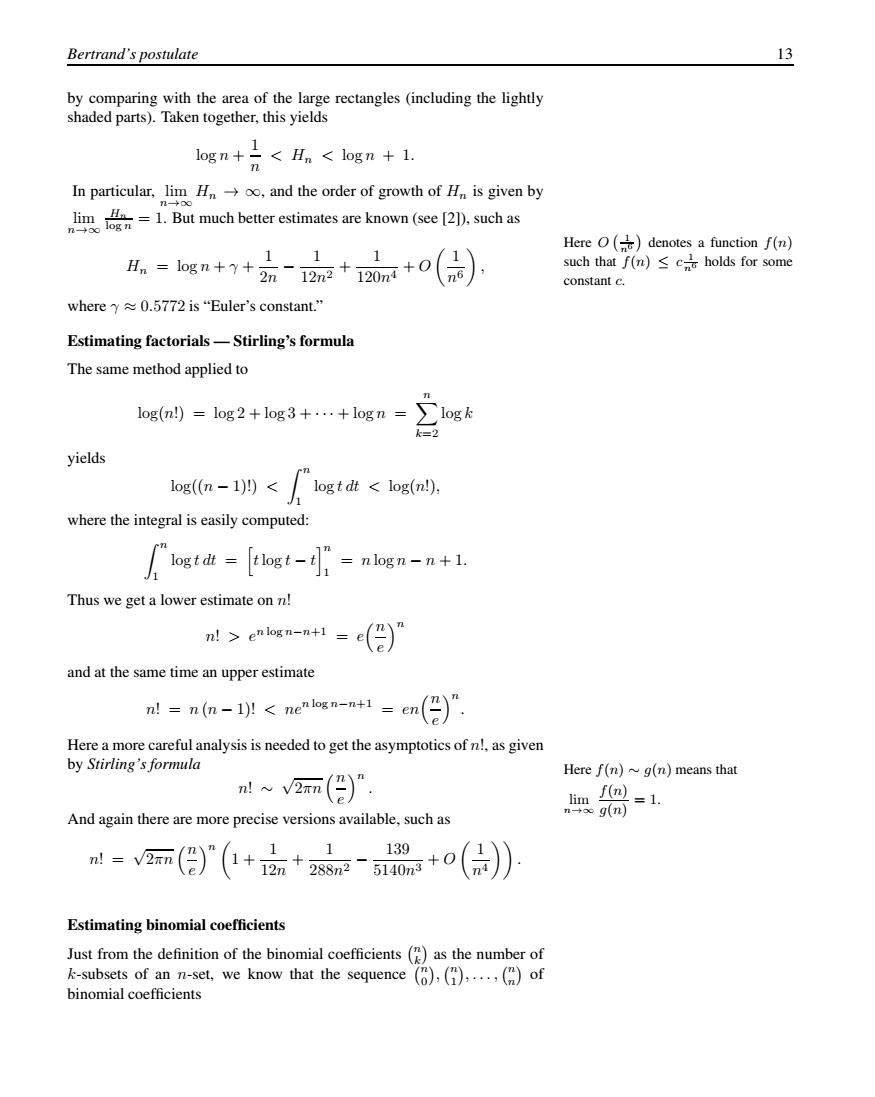正在加载图片...

Bertrand's postulate 13 by comparing with the area of the large rectangles(including the lightly shaded parts).Taken together,this yields 1 logn+<Hn logn 1. In particular,lim Hnoo,and the order of growth of Hn is given by 1.But much better estimates are known (see )such as Here (denotes a function f(n) A。=ogn+y+-1 1 2n-12m2+120m+ such that f(n)≤c holds for some constant c. where y≈0.5772is“Euler's constant..” Estimating factorials-Stirling's formula The same method applied to log(n=log2+log3+…+logn=∑logk k=2 yields log(n-1)月< logt dt log(n!), where the integral is easily computed: logtdi (tlogt=nlognn+1. Thus we get a lower estimate on n! nl>enlogn-.n+1=e(g)】 and at the same time an upper estimate n!=n(n-1)!<nenlogn-n+1 en( Here a more careful analysis is needed to get the asymptotics of n!,as given by Stirling's formula Here f(n)~g(n)means that n!~V2rn( lim fm=1. no g(n) And again there are more precise versions available,such as n!V2rn 139 12n 288m2- 5140n3+0 Estimating binomial coefficients Just from the definition of the binomial coefficients (as the number of k-subsets of an n-set,we know that the sequence (),(2),...,(n)of binomial coefficientsBertrand’s postulate 13 by comparing with the area of the large rectangles (including the lightly shaded parts). Taken together, this yields log n + 1 n < Hn < log n + 1. In particular, limn→∞ Hn → ∞, and the order of growth of Hn is given by limn→∞ Hn log n = 1. But much better estimates are known (see [2]), such as Here O 1 n6 denotes a function f(n) such that f(n) ≤ c 1 n6 holds for some constant c. Hn = log n + γ + 1 2n − 1 12n2 + 1 120n4 + O 1 n6 , where γ ≈ 0.5772 is “Euler’s constant.” Estimating factorials — Stirling’s formula The same method applied to log(n!) = log 2 + log 3 + ··· + log n = n k=2 log k yields log((n − 1)!) < n 1 log t dt < log(n!), where the integral is easily computed: n 1 log t dt = tlog t − t n 1 = n log n − n + 1. Thus we get a lower estimate on n! n! > en log n−n+1 = e n e n and at the same time an upper estimate n! = n (n − 1)! < nen log n−n+1 = enn e n . Here a more careful analysis is needed to get the asymptotics of n!, as given by Stirling’s formula Here f(n) ∼ g(n) means that limn→∞ f(n) g(n) = 1. n! ∼ √ 2πn n e n . And again there are more precise versions available, such as n! = √ 2πn n e n 1 + 1 12n + 1 288n2 − 139 5140n3 + O 1 n4 . Estimating binomial coefficients Just from the definition of the binomial coefficients n k as the number of k-subsets of an n-set, we know that the sequence n 0 , n 1 ,..., n n of binomial coefficients����